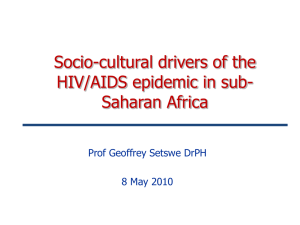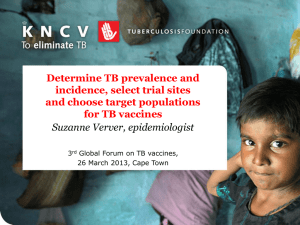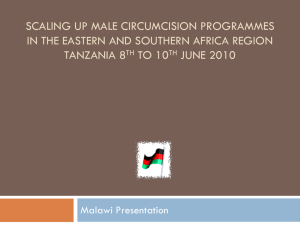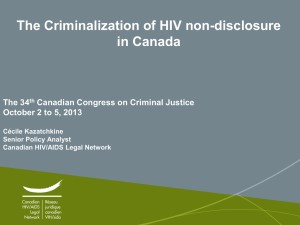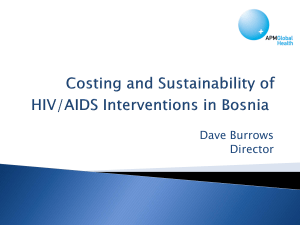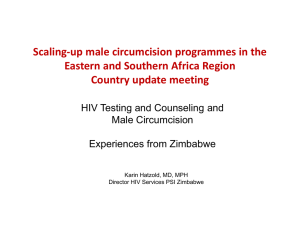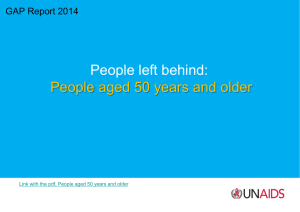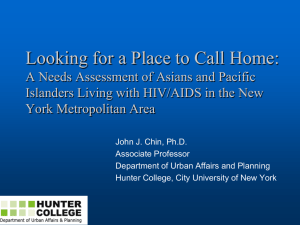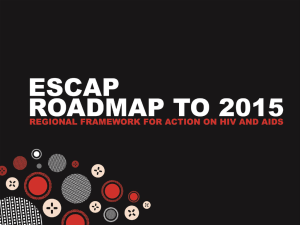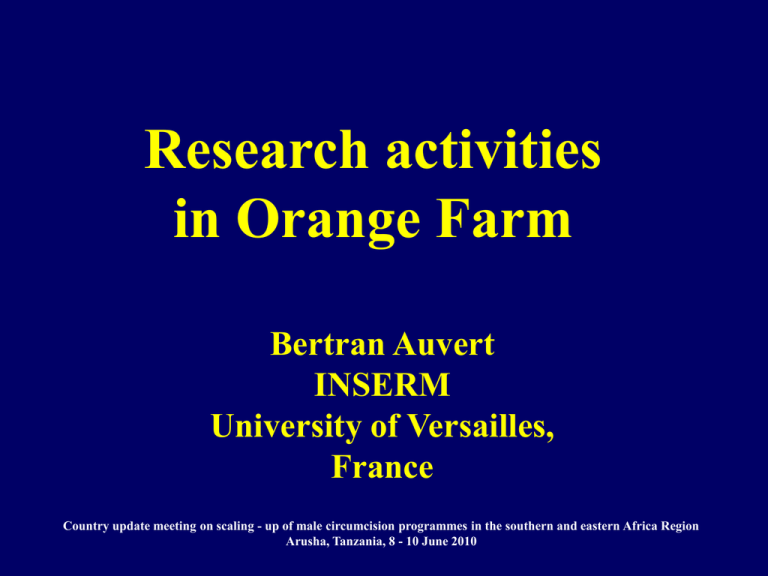
Research activities
in Orange Farm
Bertran Auvert
INSERM
University of Versailles,
France
Country update meeting on scaling - up of male circumcision programmes in the southern and eastern Africa Region
Arusha, Tanzania, 8 - 10 June 2010
Background
Orange Farm
About 200 000 people
Objective of the current project (Bophelo pele)
To roll out MC
To study the effect at community level (sexual behavior, HIV)
Schedule
2007: S1: baseline cross sectional survey (men and women)
2008 Roll out of MC
2011: S2: Second cross sectional survey
2013: S3: Third cross sectional survey
MC roll out
2008
S1 (baseline)
2009
2010
2011
S2
2012
2013
S3
1 Uptake of MC
Objective:
Proportion of uncircumcised men who will accept to become
circumcised?
Methods:
Cross sectional survey S2 in 2011 (3 years after the beginning of the roll out)
Questionnaire
Genital examination
Results:
Before 2008: MC prevalence=15%
After the roll out? In 2011. 40%? 60%?
2008
2009
S1 (baseline)
MC roll out
2010
2011
S2
2012
2013
S3
2 Who is coming for MC?
Objective:
To compare
those who are coming for MC
with those who did not come.
Comparison on HIV and sexual behavior
2010
Methods:
Sample among those who are coming for MC (2010)
Sample among uncircumcised (2011 survey)
Questionnaire (sexual behavior, condom use)
Blood sample (HIV prevalence and incidence)
Other STIs (HSV-2, HPV, NG, CT)
Results:
More at risk? Less at risk?
Difference in HIV prevalence, incidence?
2011
S2
3 Effect of MC on sexual behavior
Objective:
To compare
those who are coming for MC
with those who were recently circumcised.
Comparison on sexual behavior
2010
Methods:
Sample among those who are coming for MC (2010)
Sample among recently circumcised (2011 survey)
Questionnaire (sexual behavior, condom use)
STIs as a proxy of sexual behavior (NG, CT)
Results:
Risk compensation?
2011
S2
4 Effect of MC on HIV among women
Objective:
To compare HIV among women
having had a partner circumcised during the partnership
not having had a partner circumcised during the partnership
2010
2011
Methods:
Sample among women (2011 survey)
S2
Questionnaire (MC status of partner, sexual behavior, condom use)
Blood sample tested for HIV
Results:
Can we detect any difference in HIV incidence?
5 Effect of the roll out on HIV
Objective:
To compare HIV incidence between those
who came for MC
2010
who didn’t come for MC
2011
Methods:
S2
Sample among men (2011 survey)
Questionnaire (sexual behavior, condom use)
Clinical examination
Blood sample tested for HIV
Repeat the study in 2013 (S3)
Effect on other STIs (HSV-2, HPV)
Results:
Can we detect any difference in HIV incidence?
Sample size of the 2013 survey?
2012
2013
S3
HIV incidence ?
“Recently” infected
HIV incidence assay
“Not recently” infected
“Recently”: BED incidence assay 3 to 18 months (cut off)
It is used for HIV incidence.
Does it work for comparison of HIV incidence (HIV incidence ratios) ?
Using the blood sample collected at the final follow up visit MC trial
2946 blood tube
194 HIV+
121 Tested as “recently infected” (18 months)
RR of HIV infection (incidence rate ratio)
53% (30% to 70%)*
Trial :60% (34% to 76%)
Careful: correction for false recently infected, those under ARVs
* BMC Infect Dis. 2010 May 27;10(1):137
Acknowledgement
Orange Farm population (South Africa)
Bophelo Project team (South Africa)
ANRS (France)
University of Versailles (France
INSERM (France)
NICD – NHLS (South Africa)


